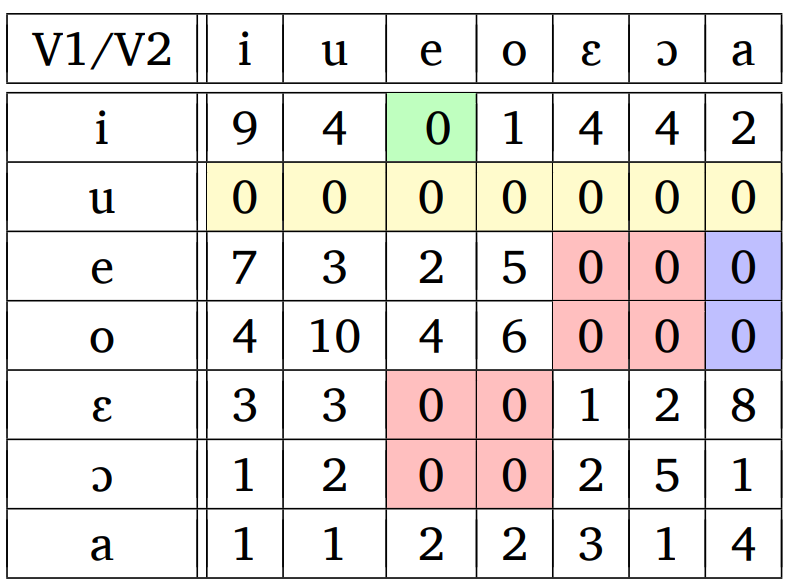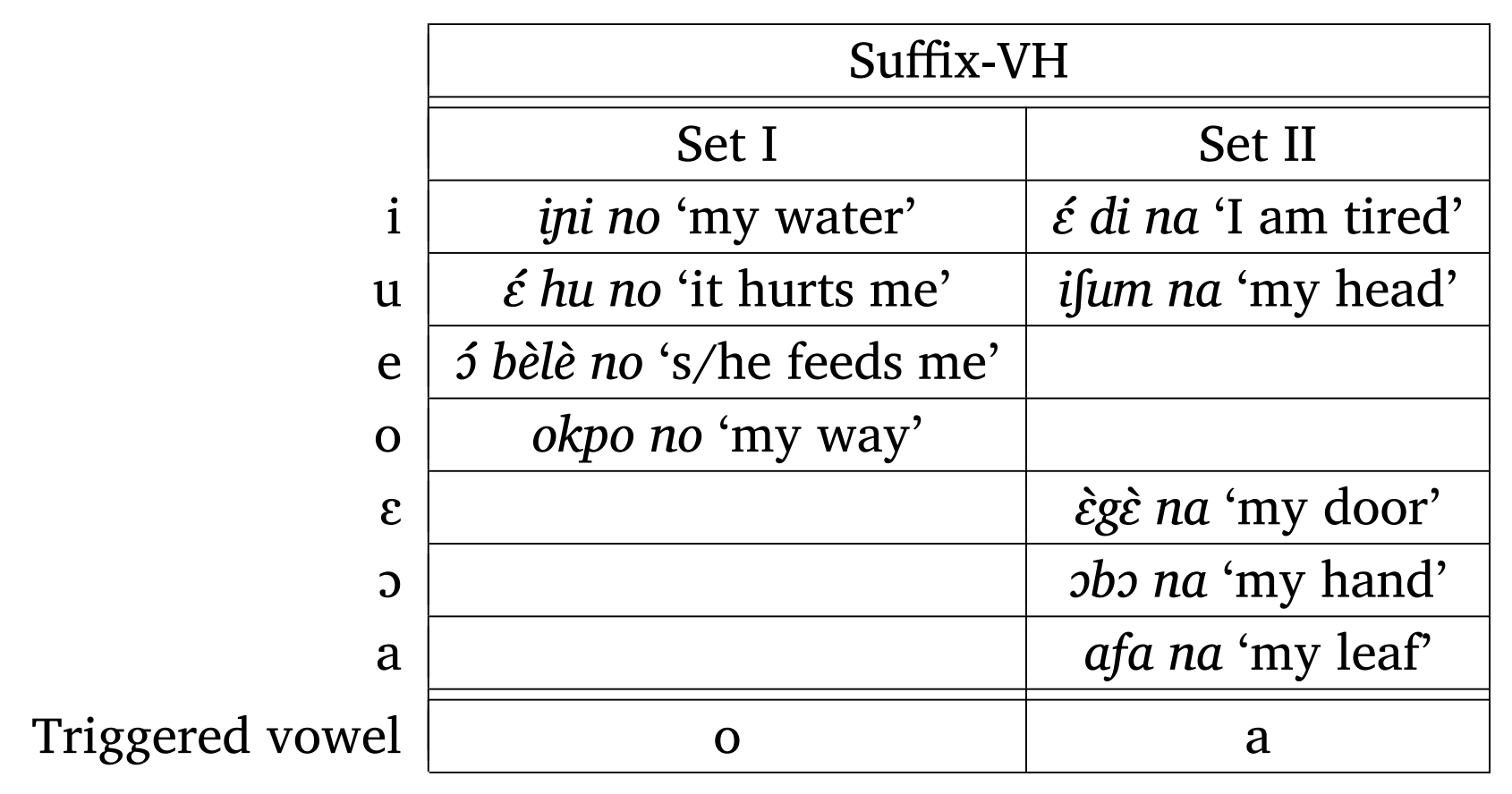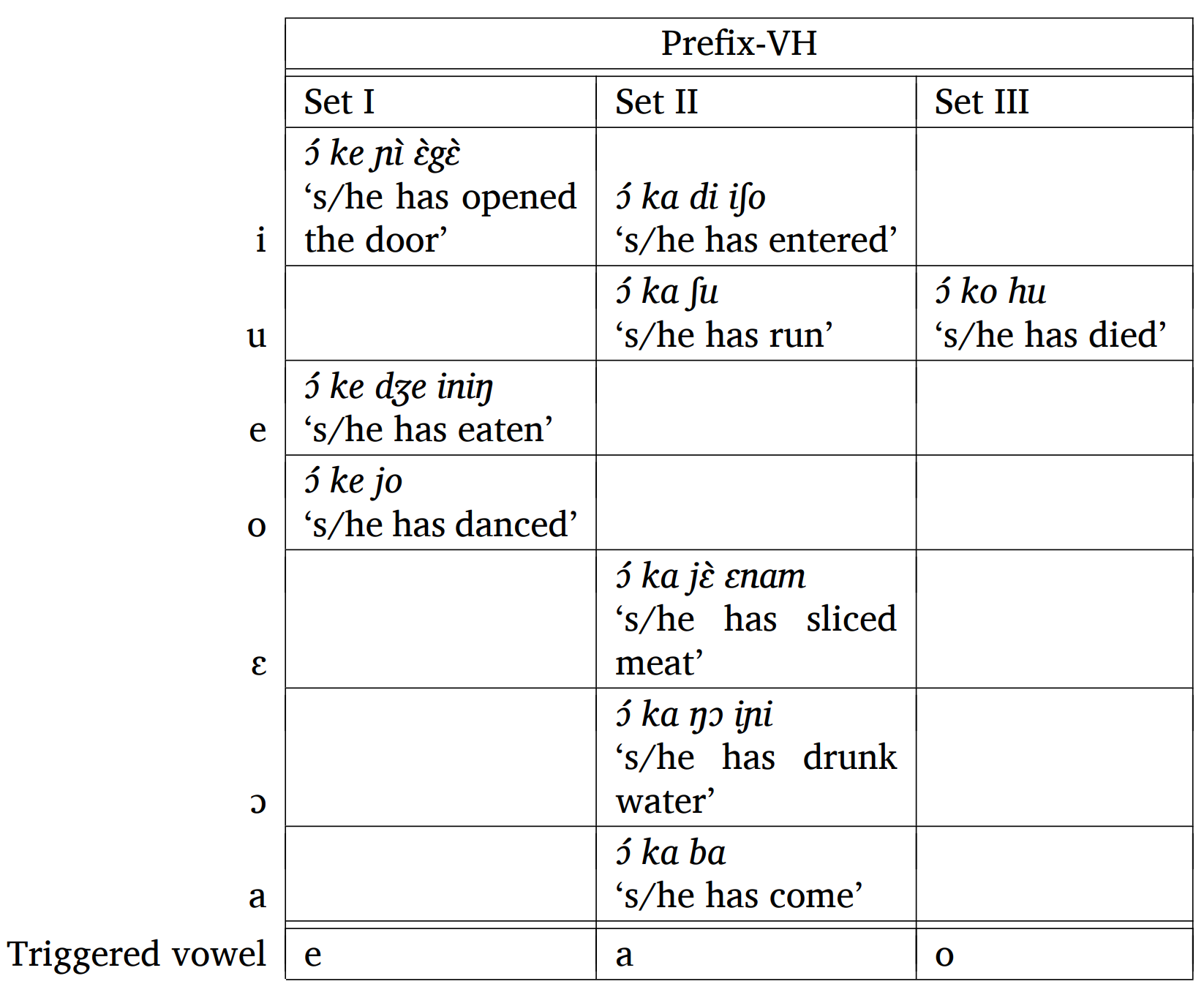Abesabesi exhibits a rather complex vowel harmony (VH) system. As comprehensive research on
this topic exists for all dialects (Agoyi 2008, 2010, 2012), this section will
cover VH in all four dialects after
presenting the findings of this research on VH in Ekiromi.
Vowel harmony is a special type of assimilation where vowels are
classified into two or more sets based on specific features and words
usually consist of only vowels of one of those sets (root-internal VH). Vowels in affixes then assimilate to
the root vowels' group in order to fit into that set (affix VH).
Root internal VH in Ekiromi does not allow
a clear distinction of separate vowel sets. However, some restrictions
exist on which vowels can be in a single word. Vowel distribution in
basic Ekiromi lexemes1 has three peculiarities (see Table 2.1): Firstly, the [+ATR] mid vowels /e/ and /o/ never
appear in a basic lexeme with [-ATR] vowels /ɛ/ and /ɔ/ (red
shading). As Ekiromi features an ATR
distinction only among the mid vowels, root-internal ATR-VH also
seems to be restricted to the mid vowels. Secondly, the low vowel
/a/ never appears directly after
one of the [+ATR] mid vowels /e/ or
/o/ (blue shading). It can,
however, appear before them. Thirdly, no word has an initial /u/ (yellow shading). This last restriction
was explained towards the end of Section 2.3. The
combination /i/ as first and /e/ as second vowel is also not attested in
basic V.CV roots. This might be a gap in the database, as there are
plenty of examples of V.CV.C-roots with this combination (e.g.,
ijel
'year'
, or
idʒej
'pounded yam'
).
Figure 2.1: Vowel distribution in non-borrowed V.CV-words. Row heads indicate the V1 and column heads indicate the V2 vowels.

Ekiromi also exhibits affix-VH. In
contrast to root-internal VH, affix-VH allows a clear distinction between vowel
sets (henceforth called Set I, Set II, and Set II). Two different VH-types can be distinguished, as VH in suffixes differs from VH in prefixes.
Suffix VH is formalized in Table 2.6 and exemplified in Figure 2.2. The latter displays alternations of the suffixed
1SG.POSS/OBJ pronoun
na/no
. Depending on the
quality of the stem's vowels, the morpheme is realized as na or no.
Like the root-internal VH, the
suffix-VH shows a clear distinction
between [+ATR] and [-ATR] of mid vowels. While the [+ATR] vowels /e/ and /o/ in a root
trigger the suffix vowel /o/, the
[-ATR] vowels /ɛ/ and /ɔ/ trigger the
suffix vowel /a/.
Table 2.6: Suffix-VH in Ekiromi
| Set I | Set II | |
| i | i | |
| u | u | |
| e | ||
| o | ||
| ɛ | ||
| ɔ | ||
| (a) | ||
| Triggered vowel | o | a |
Figure 2.2: Suffix-VH examples with 1SG.POSS/OBJ pronoun na/no

The high vowels /i/ and /u/ do not
have an overt ATR distinction. Yet, they
can trigger either suffix alternation, depending on the lexeme. This
means, if they are the only vowels of a stem, the triggered vowel is not
predictable. This is indicative of a former ATR distinction of the high vowels, which
does not surface anymore. The result is high vowels with lexically
specified ATR values. As it is not
detectable on a phonetic level, it has to be stored on a lexical level.
The vowel /a/ on the other hand behaves differently.
It can occur in both sets. As discussed earlier, it co-occurs in stems
with the [+ATR] vowels /e/ and
/o/, but only if it precedes them. These words with
/a/ as V1 and /e/ or
/o/ as V2 are in fact the only instances where
/a/ is in a word of Set I. In all other
instances, /a/ triggers the vowel
/a/ in morphemes. This is why it is attributed to
Set II, assuming that the vowel closer to the suffix is more important
for suffix VH.
The difference between the neutral vowel /a/ and the
high vowels /i/ and /u/ is their
behavior in roots containing only one type of these three vowels, such
as
afa
'leaf'
,
ta
'to build'
or
iʃi
'housefly'
. While
roots containing only the vowel /a/ trigger [-ATR] suffixes of Set II, roots only
containing high vowels take phonetically unpredictable suffixes - their
ATR value is lexically specified. For example,
afa
'leaf'
only contains
the vowel /a/. Therefore, it has the phonetically
predictable ATR value [-ATR] and takes the 1SG.POSS
suffix
na
: afa na. The ATR value of the noun
iʃi
'housefly'
on the
other hand is not phonetically predictable, as it only contains high
vowels. Its ATR value is lexically
specified as [+ATR], which is why it
takes the 1SG.POSS suffix
no:
iʃi no. Any of these three vowels
(/a/, /i/, and
/u/) can appear in a root together with the mid
vowels /e/, /o/,
/ɛ/, and /ɔ/, where the ATR value will be determined by the mid
vowels.
Suffix-VH applies to the following
suffixes: the object/possessive pronouns na/no
'1SG.POSS/OBJ', sa/so
'2SG.POSS/OBJ', and ba/bo
'3PL.POSS/OBJ', the gerund i- -aǹ
and i- -oǹ, and the
pluractionalis forms -adiàg, -odiòg, -àd, -òd, -àg, and -òg.
Prefix-VH} is formalized in Table 2.7 and exemplified in Figure 2.3. The latter displays alternations of the prefixed
PRF-morpheme. Depending on the first
vowel of the verb root, the morpheme is realized as either
ka, ke, or
ko. This type of VH behaves almost like the suffix-VH.
Only /u/ with an inherent [+ATR] value does not
belong to Set I [+ATR], but forms a separate set. The triggered vowels
are /e/ for [+ATR] vowels (Set I),
/a/ for [-ATR] vowels (Set II), and
/o/ for /u/ with an inherent
[+ATR] value.
Table 2.7: Prefix-VH in Ekiromi
| Set I | Set II | Set III | |
| i | i | ||
| u | u | ||
| e | |||
| o | |||
| ɛ | |||
| ɔ | |||
| (a) | |||
| Triggered vowel | e | a | o |
Figure 2.3: Prefix-VH examples with PRF morpheme ka/ke/ko

The following prefixes adhere to prefix-VH: the 3
SG.S
pronoun bà/bè/bò, the irrealis
pronouns náà/néè/nóò
'
1
SG.
', sáà/séè/sóò
'
2
SG.
', anáà/anéè/anóò
'
1
PL.
', asáà/aséè/asóò
'
2
PL.
', and báà/béè/bóò
'
3
PL.
', and almost all morphemes
(á/é/ó
'
PROG
', bá/bé/bó
'
FUT
', báa/bée/bóo
'
DES
', ka/ke/ko
'
PRF
', kinà/kinè/kinò
'
PRF.NEG
', màá/mèé/mòó
'
HAB
', bá wa/bé we/bó wo
'
EPN
').
Summing up, Ekiromi exhibits ATR harmony
within word-roots and a constraint of /a/ after [+ATR] vowels.
Moreover, suffixes adhere to an ATR
harmony and prefixes to an ATR harmony
with a third set consisting only of /u/.
A few CVC verbs seemingly contradict these VH types. For example, the verb
dɛ̀n
'to like'
triggers the 3
PL pronoun bè instead of bà and
the verb
kèd - 'to arrest'
triggers bà instead of bè (Examples 2.2 a, b).
Looking at vowel deletion between verbs and vowels, this can be
explained. If root vowels are deleted, vowel harmony aligns to the
deleted vowel's quality instead of the remaining vowel's (see Example
2.2 c). These seemingly contradictory cases are
thus likely to have originated as verb-noun compounds where the
underlying verb is often not retraceable.
Agoyi (2008) investigated
VH in all dialects. She claims that
ATR restrictions within a root are
only present in the Ekiromi dialect, where the mid vowels /ɛ/ and /ɔ/ can not co-occur with their [+ATR] counterparts
/e/ and /o/. The restriction of the vowel /a/,
which cannot follow a [+ATR] vowel, however, applies to all dialects.
She distinguishes six VH types based on
the features ATR, lowness, and
roundedness. Figure 2.5 and 2.6
display all six types. Type 3 (ATR+low) was added in Agoyi (2008), where she lists
two different types for the Oshugu dialect. Her analysis includes four
different domains: the prefixed
morphemes, the prefixed subject prounoun ba/be/bɔ/bo
2, the suffixed object/possessive pronouns
nã/nɔ̃/nõ, sa/sɔ/so, and ba/bɔ/bo, and the nominalization circumfix i- -anĩ/i- -enĩ/i- ɔnĩ/i- -onĩ.
Figure 2.5: VH types with two sets according to Agoyi (2008/2012b)

Figure 2.6: VH types with three sets according to Agoyi (2008)

Table 2.6: VH types in different dialects according to Agoyi (2008, 2012b)
| Domain/Dialect | Ilueni | Ekiromi | Akpes | Oshugu |
| Prefix:TAM | ATR(e) | ATR+u | ATR+round | ATR+Low |
| Prefix:PRO | ATR(e) | ATR+u | ATR+round | ATR+Low2 |
| Suffix:NMLZ | ATR(e) | ATR(o) | Low | Low |
| Suffix:PRO | / | ATR(o) | Low | Low |
These VH types are the base of her
internal classification (see Table 2.6). Each dialect
has one VH type for prefixation and one
for suffixation. The only exception is the Ilueni dialect, which has the
most reduced system with one single type for all remaining domains. A
few points of Agoyi's analysis do not match with the findings of this
thesis. Since my data is restricted to the Ekiromi dialect, additions
and changes to her analysis are only verified for Ekiromi but an
analogous application to the other dialects might be possible with more
data. Her Types 2 (ATR(o)) and 6 (ATR+u) match the Ekiromi prefixation
and suffixation VH-types described
earlier. Yet, she attributes /i/ and
/u/ only to one set in each type
and does not explain the peculiar behavior of /a/.